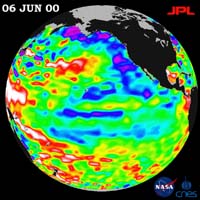| . |  |
. |
 La Nina Fades Away
La Nina Fades AwayPasadena - June 19, 2000 - After dominating the tropical Pacific Ocean for more than two years, the 1998-2000 La Nina "cool pool" is continuing its slow fade and seems to be retiring from the climate stage, according to the latest satellite data from the U.S.-French TOPEX/Poseidon mission. These data, taken during a 10-day cycle of collection ending June 9, show that the equatorial Pacific continues to warm up and is returning to normal (green) as this latest, persistent, two- year La Nina episode is coming to an end. Only a few patches of cooler, lower sea levels (seen in blue and purple) remain across the tropics. It should be noted that in June 1999, La Nina barely had a pulse, but was resuscitated in fall 1999. (See June 1999 press release) The blue areas are between 5 and 13 centimeters (2 and 5 inches) below normal, whereas the purple areas range from 14 to 18 centimeters (6 to 7 inches) below normal. In the far-western tropical Pacific Ocean, the ocean remains higher and warmer than normal. In summary, it appears that the global climate system is finally emerging from the past three years of dramatic swings from the extra-large El Nino of 1997/1998, which was followed by two unusually cool and persistent La Nina years, according to scientists at NASA's Jet Propulsion Laboratory. But as the northern hemisphere summer begins, above-normal sea surface heights and warmer ocean temperatures (indicated by the red and white areas) still blanket the western equatorial Pacific and much of the north and south mid-Pacific. Red areas are about 10 centimeters (4 inches) above normal; white areas show the sea surface height is between 14 and 32 centimeters (6 to 13 inches) above normal. This contrasts with the Bering Sea and Gulf of Alaska region southward along the western coast of North America, where lower-than-normal sea levels and cool ocean temperatures continue, although this pattern is also weakening. A possible switch in this larger-than-El Nino/La Nina, slower- changing pattern -- the Pacific Decadal Oscillation -- was first noticed by many scientists in late 1998. See a January 2000 press release "Let's not forget that the legacy of two years of La Nina will be with us this summer and into the fall, " said JPL oceanographer Dr. William Patzert. "Much of the nation's farmland is really dry in many regions. The reality is that the atmosphere is still acting as though La Nina remains." The National Oceanic and Atmospheric Administration's (NOAA) National Weather Service has forecasted continuing drought for much of the midwestern and southeastern United States and an active hurricane season for our coming summer. The U.S.-French TOPEX/Poseidon mission is managed by JPL for the NASA's Earth Science Enterprise, Washington, D.C. JPL is a division of the California Institute of Technology in Pasadena.
SOLARSTORMS AT TERRADAILY.COM
|
| |||||||||
| The content herein, unless otherwise known to be public domain, are Copyright 1995-2016 - Space Media Network. All websites are published in Australia and are solely subject to Australian law and governed by Fair Use principals for news reporting and research purposes. AFP, UPI and IANS news wire stories are copyright Agence France-Presse, United Press International and Indo-Asia News Service. ESA news reports are copyright European Space Agency. All NASA sourced material is public domain. Additional copyrights may apply in whole or part to other bona fide parties. Advertising does not imply endorsement, agreement or approval of any opinions, statements or information provided by Space Media Network on any Web page published or hosted by Space Media Network. Privacy Statement All images and articles appearing on Space Media Network have been edited or digitally altered in some way. Any requests to remove copyright material will be acted upon in a timely and appropriate manner. Any attempt to extort money from Space Media Network will be ignored and reported to Australian Law Enforcement Agencies as a potential case of financial fraud involving the use of a telephonic carriage device or postal service. |